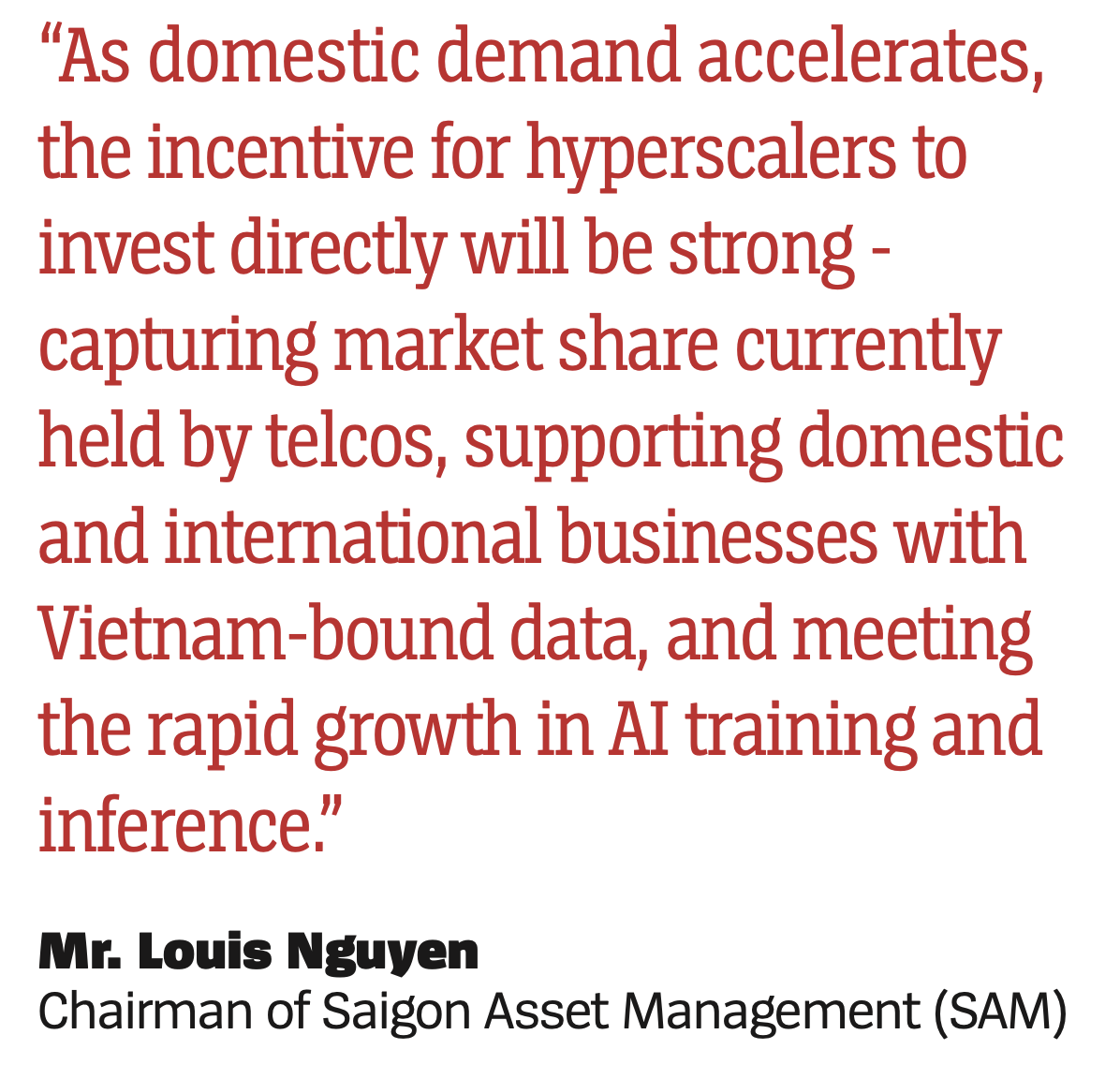
The amended Law on Telecommunications, which allows foreign investors to own 100 per cent of data center projects, took effect in July 2024. However, foreign companies have yet to take advantage of this full ownership opportunity. What are your thoughts on that?
The challenge for hyperscalers - tech giants that own and operate hyperscale cloud infrastructure - doesn’t lie in ownership but in the certainty of Vietnam’s data governance framework. They hesitate to invest billions of dollars in hyperscale data centers without clear rules on data sovereignty. Amending the Law on Telecommunications was necessary, but the amendments do not fully address practical concerns.
Even with 100 per cent ownership allowed, hyperscalers remain cautious because current regulations on data transfer and control are not fully clear. For US-listed companies like AWS, Google, and Microsoft, clarifying how data is stored, managed, and transferred across borders is a prerequisite before committing billions of dollars.
For Chinese hyperscalers, these issues are generally less restrictive, unless they plan to list in the US. In short, the ownership barrier has been removed, but the legal framework on data sovereignty and compliance still needs improvement to build investor confidence.
Once these issues are resolved, Vietnam’s fundamentals - rapidly-growing demand, strategic location, and infrastructure advantages - will make it highly attractive.
Is that why hyperscalers have not yet built data centers in Vietnam?
Exactly. Data sovereignty and privacy clarity are the biggest obstacles. Two other factors matter - infrastructure readiness and domestic demand. Hyperscalers need reliable power (including renewable energy), land, water, fiber-optic networks, and submarine cable connectivity - to be in place before committing billions.
On the market side, Mordor Intelligence recently estimated Vietnam’s data center market at around 525 MW. Our internal analysis suggests roughly 50 per cent of this is owned by local telcos, with 40 per cent served by hyperscalers from Singapore-based facilities and 10 per cent operated by banks or enterprises themselves.
As domestic demand accelerates, the incentive for hyperscalers to invest directly will be strong - capturing market share currently held by telcos, supporting domestic and international businesses with Vietnam-bound data, and meeting the rapid growth in AI training and inference. These pull factors will determine when - not if - they establish data centers in Vietnam.

The figure of 40 per cent of data potentially stored outside Vietnam is significant, don’t you think?
This number simply reflects customer preference - for example, for Meta (Facebook and Instagram) or Alphabet (Google and YouTube) - as well as the fact that major international data center operators are still waiting for clearer and more enforceable data regulations in Vietnam.
If these “giants” enter Vietnam, can domestic partners meet their needs?
In theory, hyperscalers could build data centers on their own, but in practice, they almost always partner with local companies to ensure smooth operations and reduce risks. For example, NTT from Japan, despite being in Vietnam for over 15 years, chose to cooperate with QDTek to launch a data center at the Saigon Hi-Tech Park in Ho Chi Minh City; while ST Telemedia from Singapore deployed a data center at the city’s Tan Thuan Export Processing Zone with VNG.
Vietnamese companies like Viettel, VNPT, FPT, and CMC already operate data centers capable of meeting customer demand, and we play a role in connecting clients with these major data center providers.
Data center projects are extremely complex, not only in terms of investment but also regarding land use rights, power (including renewable energy), water, fiber-optic connectivity, and various permits. It is almost impossible for a foreign investor to handle everything alone, so strategic alliances with local partners are essential.
Typically, hyperscalers set up multiple redundancies, work with several partners, and allocate 10-50 MW of capacity to each, rather than relying on a single operator. This means even a single major deal can benefit multiple domestic companies.
However, it should be noted that hyperscaler standards are very strict. Sites need to be near Hanoi or Ho Chi Minh City to be close to customers, with fiber-optic and submarine cable connectivity, stable geology (to avoid flooding or fire risks), and guaranteed electricity and water supply. They also need partners who understand Vietnam, can operate at scale, and navigate legal procedures effectively. This is both a challenge and an opportunity - if Vietnamese companies can meet technical standards and provide confidence regarding ownership and data compliance, they may even gain direct access to customers.
We (SAM and the Katalyst Data Center) are working directly with hyperscalers and global tech giants. We understand their technical requirements and have an even deeper understanding of Vietnam’s legal and business ecosystem. Therefore, we are determined to connect them with regulators so both sides can reach common ground, allowing Vietnam to seize the opportunity.
What do you discuss with hyperscalers to encourage them to enter Vietnam?
We focus on both principles and concrete commitments. From the foreign side, if Vietnam clarifies the legal framework, are they ready to commit billions of dollars, and what will they contribute to digital infrastructure? From the government side, the priority is protecting security and data sovereignty while still enabling growth. The main goal is to foster mutual understanding to reach practical compromises.
From one perspective, foreign companies are like tourists: they will only come and stay if the destination is attractive and welcoming.

Six months after its launch, how is the SAM / Katalyst DigitalHub data center project progressing?
Vietnam has chosen a development path based on technology and innovation. Data center infrastructure is the foundation of this transformation. With AI booming, from model training to everyday applications, demand for storage, computing, and AI training in Vietnam will surge in the years to come.
At SAM and Katalyst DigitalHub, we are in deep discussions with several international investors, including two major groups from the US and Japan, all of which have expressed strong interest in developing facilities on our 50-ha site. They see Vietnam’s data storage demand growing rapidly year-after-year, and if they do not enter soon they risk missing opportunities in a young but fast-growing market.
We have observed that Malaysia has attracted over $40 billion in just a few years, yet ironically, they are now limiting new permits due to power and water shortages. This opens a major opportunity. Hyperscalers will inevitably turn to Vietnam, Thailand, and the Philippines as nearby hubs. With proper alignment between hyperscalers and the Vietnamese Government, I believe Vietnam can welcome a similar wave of investment, in line with the country’s vision for technology and innovation.
What can Vietnam learn from Malaysia?
Malaysia’s success comes from a combination of clear regulations, proactive government support, and ready infrastructure. It positioned itself as a natural alternative when Singapore lacked land and power for new hyperscale campuses.
The Malaysian Government actively invited global tech giants by introducing transparent policies, fast approval mechanisms, flexible cross-border data regulations, and attractive incentives. It also prepared large land plots, reliable power (including renewable energy), and strong submarine cable connectivity - creating an ecosystem that reassures hyperscalers to invest tens of billions of dollars.
In reality, Malaysia’s infrastructure is not necessarily superior to Vietnam’s. International partners have already eyed Vietnam as a new market. We have a fast-growing digital economy, a young population, a strategic location, and increasing AI adoption.
To attract similar investment, Vietnam should focus on establishing a clear legal framework on data sovereignty, privacy, and cross-border flows; prepare large-scale infrastructure (power - especially renewable, and water, fiber, and land); and proactive government support with fast mechanisms, incentives, and international cooperation.
If policy and infrastructure align with market demand, Vietnam can not only compete with Malaysia but potentially surpass it, thanks to market size and proximity to Asia’s digital growth centers.








 Google translate
Google translate